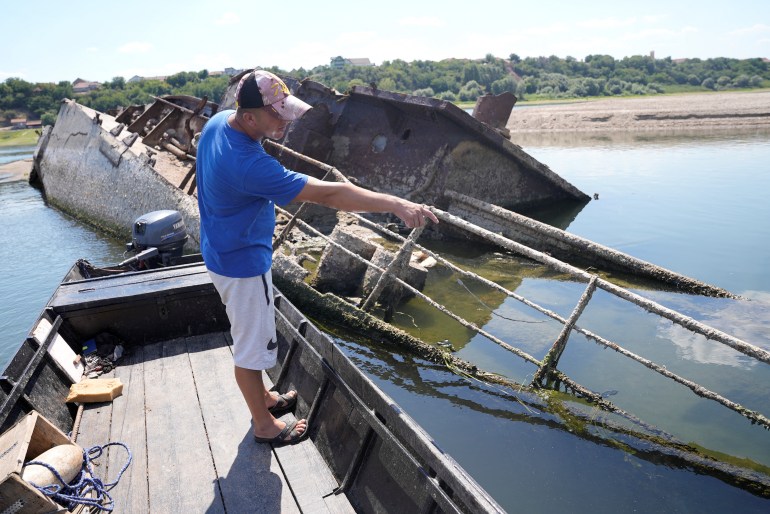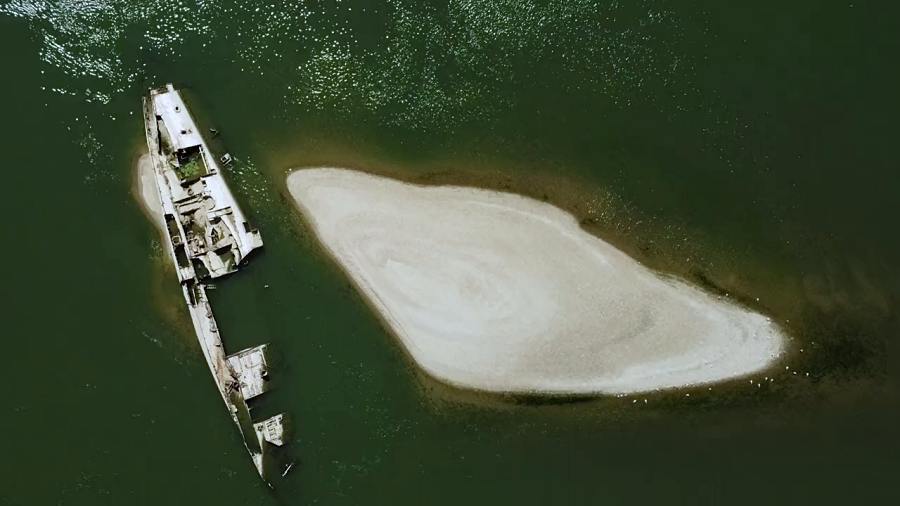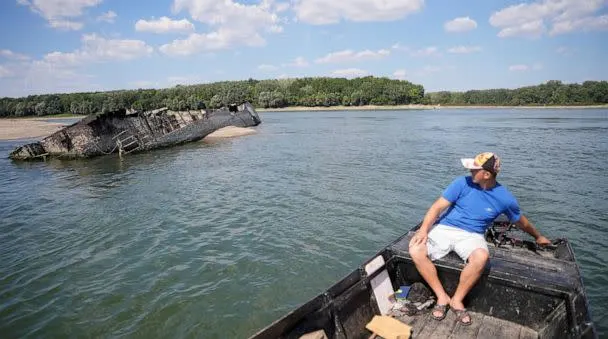Wed 09 November 2022:
As the climate crisis causes water levels to plummet, riverbeds to dry and glaciers to melt, artefacts like old warships, an ancient city and human remains have emerged. This story is part of “Climate artefacts”, a mini-series telling the stories behind the people, places and objects that have been discovered due to drought and warming temperatures.
Around midnight on September 6, 1944, a series of loud explosions woke Vojislav Lapadatovic from his sleep in the Serbian village of Prahovo.
The 20-year-old, who had been resting on a haystack, dashed towards the river, where for several days Prahovo had been hosting some unusual visitors.
In the dying months of the second world war, the Soviet Union marched through Eastern and Central Europe, its Red Army pushing Nazi Germany back towards Berlin while sweeping south through Romania to secure the Balkans.
Fleeing its advance, the remaining ships of the German Black Sea fleet had travelled approximately 860km (534 miles) up the Danube, where they had stalled in Prahovo, unable to progress further against enemy forces.
“I ran the 150 meters (almost 500 feet) to the bank of the Danube,” Lapadatovic told German magazine Der Spiegel in 2003. “The Germans sank their fleet, including the massive three-storey hospital ship for the wounded at the front.”
The Germans offloaded what cargo and weapons they could before scuttling the ships in a zigzag formation to obstruct enemy ships.

The wrecks are littered along a 43km (26-mile) stretch of the Danube, Europe’s second-longest river, which runs through 10 countries from its source in south Germany to the Black Sea in Romania. The greatest concentration of these wrecks is near Prahovo, where at least 40 lie on the riverbed. Their remains resurface periodically in times of intense dryness, including earlier this year, when the level of the Danube reached historically low levels amid a prolonged drought across Europe.
When the level water drops, some of the rusted hulls, twisted and broken, jut out of the sandbanks, their gun barrels and command bridges visible once again after almost 80 years.
A sitting duck
Although the Black Sea was not a major naval theatre during the war, Germany dispatched several hundred small ships to the inland sea. They were used primarily to secure supplies to the German army via Ukrainian ports captured after the invasion of the Soviet Union in 1941.
Too small to ever take on the region’s vastly larger Soviet fleet, it nevertheless played an important role in the siege and capture of the strategic port of Sevastopol in Crimea in 1942.
The fleet’s last mission began in August 1944, when the Soviet Union’s Second Jassy–Kishinev offensive, a push through the front lines in northern Romania, encircled and crushed the German Sixth Army, paving the way to a full takeover of the Balkans.
A battle group was formed under Zieb, a career naval officer who had run the German shipyard in Bucharest, to attempt the ambitious operation.
According to an account by archaeologist and historian Gordana Karović, the heavily armed convoy, up to 25km (15 miles) in length, consisted of between 170 and 250 naval craft, including cargo ships, patrol boats, tankers, landing ships and one hospital ship, the Bamberg. More than 4,000 were on board, among them at least 1,500 civilians.
On August 23, two days before Zieb’s fleet set off up the Danube, Romania’s King Michael successfully deposed the Nazi puppet leader Ion Antonescu and immediately ended his country’s allegiance to the Axis powers.

Romanian troops, who had been Germany’s allies just days before, then harried the convoy with artillery, sinking dozens of ships and killing hundreds of those on board at Cernavodă, in the country’s east, and Calafat, near the Serbian border in the west.
After arriving at Prahovo on September 2, landing and artillery ships made four attempts to breach further up the river but were repelled with heavy losses. Zieb used the village’s airfield to fly to Belgrade, where he received news that the Red Army had taken the Iron Gates, a steep gorge that controls the passage of traffic on the Danube.
Cut off from German forces in Serbia, the fleet became a sitting duck for the reinforced Soviet and Romanian armies, who controlled the Danube’s left bank.
Some troops and equipment were evacuated from Prahovo’s train station, while others headed towards Belgrade on foot, which remained in German hands until the Yugoslav partisans of Josip Broz Tito captured it on October 20.
Botched recovery
The wrecks of the Black Sea fleet, many of which contained ammunition or explosives, have endangered traffic on the Danube ever since they were sunk. Hundreds of cruise ships pass by each year and can face several-hour delays due to the obstruction.
Although the Soviet Union and Yugoslavia removed several dozen ships after the war, most remain today exactly where they sank.
In recent years, the Serbian government has attempted to finally clear the obstruction.

Although authorities believe they have located all the remaining unexploded mines, many have not yet been extracted due to the dangers and high costs involved. Serbia invited tenders for the recovery project in March, which it estimated would cost 29 million euros ($28.8m).
According to broadcaster Radio Television of Serbia, a botched recovery by Romania in the 1980s led to an explosion that killed 10 people.
A number of questions remain surrounding the sinking of the German fleet. The large hospital ship Bamberg has not yet been identified among the wrecks, although multiple witness sources claimed to have seen it sunk, possibly with dead or wounded still on board.
Exactly how many of the thousands of troops and civilians on board the convoy managed to safely return to German-controlled territory in Serbia, by train or by foot, is also unclear.
“We sabotaged the project with the partisans,” claimed Lapadatovic. “The train derailed and crashed into a canal. Most of the passengers died.”
Zieb, who escaped by plane, was awarded the German Gold Cross upon his return home and later became shipyard director at Wilhelmshaven, Germany’s major North Sea naval base.
The final task of the commander who sank Germany’s Black Sea fleet was to prevent the sabotage or scuttling of what remained of the Kriegsmarine before its ships could be divided by the Allies as spoils of war.
By: Ruairi Casey | SOURCE: AL JAZEERA
___________________________________________________________________________________________________________________________________
FOLLOW INDEPENDENT PRESS:
TWITTER (CLICK HERE)
https://twitter.com/IpIndependent
FACEBOOK (CLICK HERE)
https://web.facebook.com/ipindependent
Think your friends would be interested? Share this story!






